 MyDogBreeds
MyDogBreeds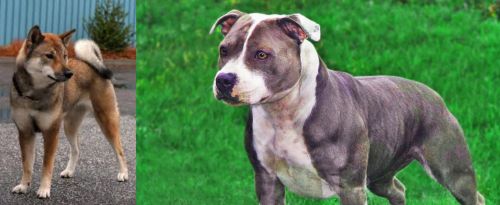 Shikoku is originated from Japan but Irish Staffordshire Bull Terrier is originated from Ireland. Shikoku may grow 21 cm / 8 inches shorter than Irish Staffordshire Bull Terrier. Shikoku may weigh 35 kg / 78 pounds more than Irish Staffordshire Bull Terrier. Both Shikoku and Irish Staffordshire Bull Terrier has almost same life span. Both Shikoku and Irish Staffordshire Bull Terrier has almost same litter size. Shikoku requires Moderate maintenance. But Irish Staffordshire Bull Terrier requires Low maintenance
Shikoku is originated from Japan but Irish Staffordshire Bull Terrier is originated from Ireland. Shikoku may grow 21 cm / 8 inches shorter than Irish Staffordshire Bull Terrier. Shikoku may weigh 35 kg / 78 pounds more than Irish Staffordshire Bull Terrier. Both Shikoku and Irish Staffordshire Bull Terrier has almost same life span. Both Shikoku and Irish Staffordshire Bull Terrier has almost same litter size. Shikoku requires Moderate maintenance. But Irish Staffordshire Bull Terrier requires Low maintenance
 The Shikoku is from the Shikoku Island in Japan and they are very much like the Japanese Shiba Inu. There are six native Japanese dog breeds and the Shikoku is medium sized and sits in between the smaller Shiba Inu and the very large Akita Inu. All of the Japanese native breeds are members of the Spitz family. The Japanese have sorted their six breeds into 3 categories by size. Being medium size, the Shikoku is a member of the Shika-inus group. Others in this group are the Ainu Ken, the Kai Ken and the Kishu Inu. There are small differences between the three dogs in the Shika-inus group.
The Shikoku is from the Shikoku Island in Japan and they are very much like the Japanese Shiba Inu. There are six native Japanese dog breeds and the Shikoku is medium sized and sits in between the smaller Shiba Inu and the very large Akita Inu. All of the Japanese native breeds are members of the Spitz family. The Japanese have sorted their six breeds into 3 categories by size. Being medium size, the Shikoku is a member of the Shika-inus group. Others in this group are the Ainu Ken, the Kai Ken and the Kishu Inu. There are small differences between the three dogs in the Shika-inus group.
The Shikoku was bred to be a hunting dog in Kochi Prefecture to hunt boar and deer. Other names for the breed include Kochi-ken and Kishu dog or boar hound. This dog is considered to be the purest of the Japanese native dogs or Nihoken. They are today very , very rare. There are very few outsides of Japan, but some in North America are attempting to save the breed.
The are od Kochi Prefecture is a mountainous region with rough terrain that anyone outside of the area would have a hard time accessing. That is why the Shikoku is considered to be so pure as they were pretty well isolated in the mountains. The breeders were also isolated by the mountains and there was very little interbreeding. Although breeding the same dog, these different groups developed different lines of the Shikoku.
Documentation tells us that the number of originals lines was just two and these were the Western and Eastern Shikoku. The Western dog was known as the Mount Ishizuchi Shikoku and the Eastern as the Mount Tsurugi Shikoku. Within these two lines of Shikoku there are additional strains.
Within the Eastern line there is the Tokushima (lya) and the Koci-Aki strains. Within the Western line there is the Hata Uwahara, the Ehime-ken Shuso-gun and the Honkawa. Among these lines and strains, there are different coats and different colors; some heavier and some taller, but all figure into the development of the breed.
Finally, in the Showa Era the Japanese established the Dog Protective League and they began collecting the native dogs from around the country. They protected them so that the breed will go on. The Shikoku is today recognized as Foundation Stock by the AKC and it is fully recognized by the Japan Kennel Club, the Canadian Hound Club and the Shikoku has been declared a living Japanese “natural monument”.
Two bloodlines became the way the Shikoku were know after the war – the Honkawa and the Hata lines The Honkawa line were the descendants of the Choshun-go and the Hata line were the descendants of the Matsukaze-go. They bred the lines separately until 1955, when they mixed them to make the breed stronger. They are no longer considered separate in any way.
Because they are such primitive dogs, the Shikoku are good watch dogs and quite reserved with strangers. They need a lot of socialization to be a family pet but once they are, they make great companions. Intelligent, quick to learn and eager to please. Of the two lines of Shikoku dogs from the Western strains, the current Shikoku owes much of its current development to the Honkawa and Hata strains.
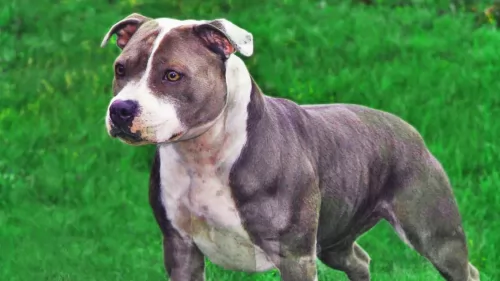 The Staffordshire Bull Terrier comes from Staffordshire, England, but the Irish Staffie was later developed by Irish breeders so its origin is essentially Ireland. They were developed from bulldogs and different terrier breeds.
The Staffordshire Bull Terrier comes from Staffordshire, England, but the Irish Staffie was later developed by Irish breeders so its origin is essentially Ireland. They were developed from bulldogs and different terrier breeds.
The dog was always used for bull baiting, but when this sport died out, the Irish breeders wanted to create a taller, leaner dog suited for dog fighting. When dog fighting was banned the breed became rare again, but today it has been restored and is essentially a popular companion pet.
 Today’s Shikoku is a medium sized breed with a Spitz like body – square with a head that is wedge shaped. The ears are pointed, and the tail is curved and feathered. They have arched toes and hard pads with dark, hard nails.
Today’s Shikoku is a medium sized breed with a Spitz like body – square with a head that is wedge shaped. The ears are pointed, and the tail is curved and feathered. They have arched toes and hard pads with dark, hard nails.
The two lines of the Shikoku are slightly different in built and look. The Honkawa strain is slender and athletic; agile and single coated. They have dark eyes and most of them are black and tan.
On the other hand, the Hata strain is much heavier boned, with the front more muscular than the rear. They have small ears, a wide skull and a strong undercoat. His eyes are shaped differently than the Honkawa. Their coats are also mostly red and tan.
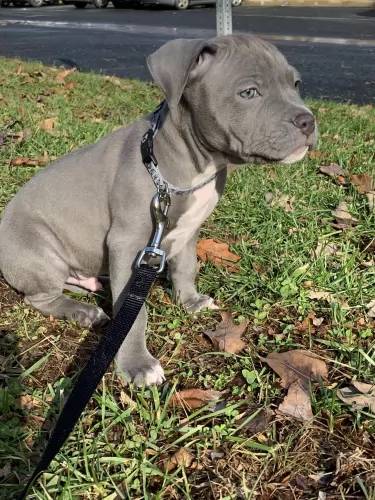 The Irish Staffordshire Bull Terrier is a medium sized pure-breed dog standing at roughly 43 to 48cm and weighing anything from 14 to 18kg.
The Irish Staffordshire Bull Terrier is a medium sized pure-breed dog standing at roughly 43 to 48cm and weighing anything from 14 to 18kg.
He has a short, smooth coat which can be a mix of colors such as fawn, tan, black or brindle. The coat can also be bi-colored such as in fawn and white or black and white. He is a powerfully built dog with short legs which are fairly wide apart.
He has a large head and short muzzle with powerful jaws.Sometimes when he pants after a hectic bout of exercise he gets a comical, grinning look on his face. The ears are semi-erect, semi-upright and he has a long tail.
Your Irish Staffy is a feisty, confident dog that has been known to have a temperament which leads towards aggression. It is why he should be trained and socialized to make him more amicable and obedient. He is an intelligent and alert dog, so won't have difficulty with training.
A well trained and socialized Irish Staffordshire Bull Terrier will get on well with children in the home as he is a playful, jovial dog, always ready for a game.
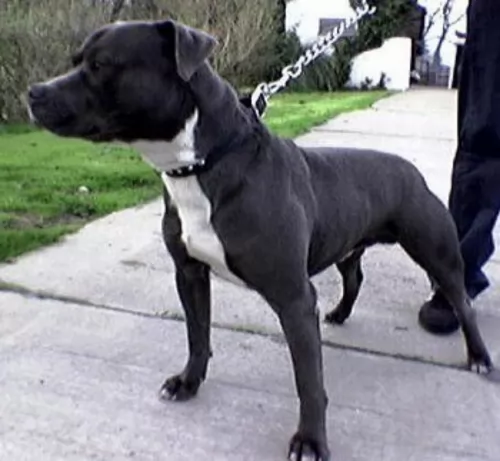 The older Irish Staffie has always been an aggressive type dog used for fighting, but today the modern breed is capable of being a splendid, entertaining, amicable pet with an even temper. He is feisty for sure, being brave, fearless, loyal and loving with his human family members.
The older Irish Staffie has always been an aggressive type dog used for fighting, but today the modern breed is capable of being a splendid, entertaining, amicable pet with an even temper. He is feisty for sure, being brave, fearless, loyal and loving with his human family members.
All it requires with this dog is to have a firm, loving upbringing, some training and socialization as well as good food and plenty of love and attention. Many dogs get labelled wrongly because of the humans that rear them the wrong way. When done correctly, the Irish Staffordshire Bull Terrier promises to be a wonderful, loving, loyal pet.
 Being isolated as they were, the Shikoku was a fairly healthy breed, no genetic testing has been done. Despite this they suffer a few of the same potential issues as other breeds their size.
Being isolated as they were, the Shikoku was a fairly healthy breed, no genetic testing has been done. Despite this they suffer a few of the same potential issues as other breeds their size.
Otherwise this is an agile and hardy breed with no known congenital health issues.
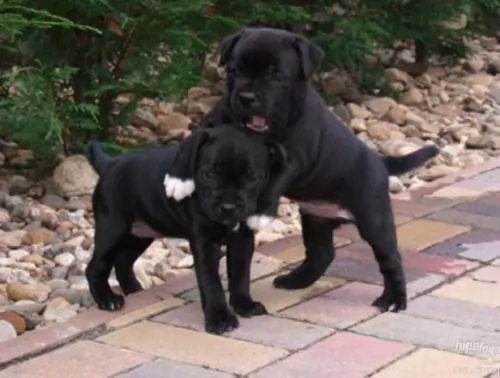 The Irish Staffordshire Bull Terrier, just like with any other dog, has a good chance of living a good number of years if he is fed properly. He can live to be anything up to between 10 and 16 years.
The Irish Staffordshire Bull Terrier, just like with any other dog, has a good chance of living a good number of years if he is fed properly. He can live to be anything up to between 10 and 16 years.
Say what you like, good nutrition and the lifestyle you provide for your Irish Staffie will determine how long he lives. An unhappy dog that has to beg for love and attention won't do well. Your Irish Staffie can live to a ripe age but he is still at risk for certain health problems.
These mast cell tumors are graded according to their location in the skin. Certain dogs like Boxers and bulldogs are more susceptible to mast cell tumors than other breeds, and the Irish Staffie isn't immune either. Most times the tumor develops in an older dog, though young dogs have also been known to develop the tumor. These tumors can be inactive for a while and then experience some rapid growth with some redness and fluid build up. Immediate veterinary intervention will be required.
 Feeding the puppy Be careful with feeding the puppy and adult as the breed is known to have a tendency toward obesity. Fresh food is better as it is what the breed has been used to, but a high quality puppy kibble is acceptable. Feed three times per day.
Feeding the puppy Be careful with feeding the puppy and adult as the breed is known to have a tendency toward obesity. Fresh food is better as it is what the breed has been used to, but a high quality puppy kibble is acceptable. Feed three times per day.
2.Feeding the adult He is a high energy dog so feed a high energy food designed for a medium sized dog. Feed in two meals each day.
4. Games and Exercises You will need a fenced yard for this breed and time to play with them. If not, you would need time to walk her more than once a day. They love to play indoors as well, chasing balls, learning new things. The breed make great companions for hiking, swimming, play frisbee or catch outside. They do well at agility, rally, obedience and flyball.
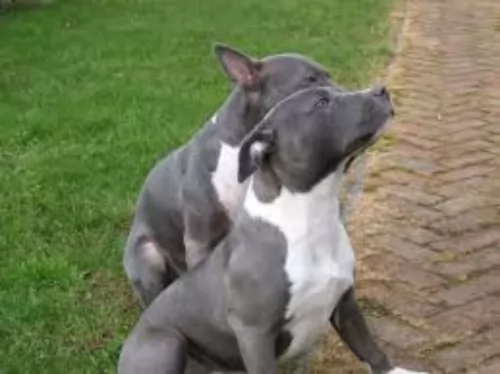 The Irish Staffie is an active dog, who is always game for anything. He will certainly need active owners who include him in all their activities. He has a lot of stamina and endurance and will want to join you on your walks, hikes and swimming. Ignoring his exercise needs can turn him into a restless, unhappy, frustrated, destructive dog.
The Irish Staffie is an active dog, who is always game for anything. He will certainly need active owners who include him in all their activities. He has a lot of stamina and endurance and will want to join you on your walks, hikes and swimming. Ignoring his exercise needs can turn him into a restless, unhappy, frustrated, destructive dog.
Having a short, smooth coat means your Irish Staffie being a low maintenance dog. He does shed a bit so his coat will need to be brushed at least twice a week to get rid of all those loose hairs. Its always a good opportunity to check him for fleas and ticks too.
If the short coat gets too dirty, a wipe down with a damp cloth can keep the coat bright and shiny. Certainly avoid bathing him too often as this can aggravate the skin.
Check his nails and trim them if they get too long. Check his ears and teeth as these are all problem areas which can contribute to your dog becoming ill.
Your Irish Staffie is such an energetic dog that he will need excellent food that promotes this energy. Whether you buy him the best commercially manufactured kibble, you want to also add in some home-made food such as cooked chicken, rice and vegetables as well as including some raw meat occasionally. The food you provide your Staffie with needs to be full of vitamins and minerals to avoid illness. Always make sure he has access to fresh, cool water.